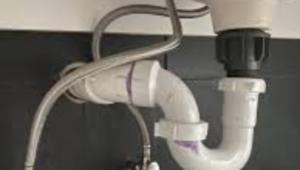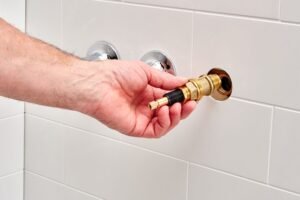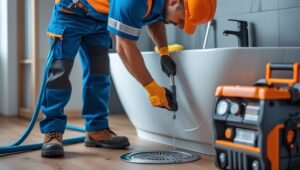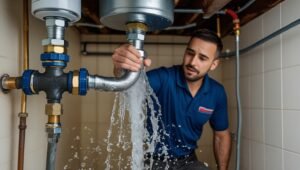How to Plumb Sink Drain PVC to Galvanized Pipe? Connecting a PVC sink drain to an older galvanized metal pipe requires specific tools and techniques to ensure a durable, leak-free connection. While a licensed plumber often handles these connections, understanding the process can help homeowners make informed decisions about their plumbing systems. Here’s a guide to why combining PVC and galvanized pipes is often necessary, how to make the connection safely, and common mistakes to avoid.
How to Plumb Sink Drain PVC to Galvanized Pipe? Step by Step:
Why Use Both PVC and Galvanized Pipes?
Both PVC and galvanized pipes have unique advantages, making each suitable for different plumbing applications. PVC pipes are popular for their lightweight, corrosion-resistant properties, and flexibility, making them ideal for drainage and vent piping. Galvanized pipes, on the other hand, are known for their durability but can corrode over time, especially in hot water applications. Combining PVC and galvanized pipes can be both practical and cost-effective for retrofits or repairs, particularly in older systems.
Benefits of PVC Pipes
PVC (Polyvinyl Chloride) is widely used in modern plumbing due to its flexibility, lightweight structure, and ease of installation. It’s ideal for drainage and venting applications, as well as for outdoor plumbing where cold water is present. PVC is resistant to chemicals in drain cleaners, helping prevent buildup and reduce clogs over time. For these reasons, many homeowners prefer PVC when replacing or retrofitting existing plumbing.
Galvanized Metal Pipes: Durable but Prone to Corrosion
Once the standard in residential plumbing, galvanized pipes have a protective zinc coating that guards against rust in the short term. However, they can corrode over time, reducing water flow and increasing the risk of leaks. Replacing or retrofitting these pipes with PVC or CPVC (Chlorinated Polyvinyl Chloride) can improve efficiency and prevent leaks, especially during renovations.
How Forever West Plumbing Connects Galvanized to PVC Pipes
At Forever West Plumbing, we use specialized techniques to connect PVC to galvanized pipes. Here’s a look at how our licensed plumbers handle these connections:
-
Male Plastic Adapters
PVC male adapters are commonly used to connect PVC to existing metal piping. Female slip adapters are avoided as they can crack under pressure, leading to leaks and costly repairs. -
Galvanized Couplings
When connecting to a male-threaded galvanized pipe, our plumbers use a coupling to create a secure female connection where the metal and PVC meet, preventing leaks. -
Flexible Rubber Connectors
Flexible rubber connectors are ideal for drainpipes that aren’t under high pressure. These connectors have clamps on each end to ensure a watertight seal, providing flexibility for drainage applications. -
Sealants
A silicon sealant is applied to the metal end to ensure a watertight connection. It’s important to note that PVC cement isn’t used for metal-to-PVC connections, as it’s only effective for PVC-to-PVC joints.
Avoiding Common Mistakes in PVC-Metal Connections
Some DIY enthusiasts mistakenly attempt to glue PVC directly to metal, which doesn’t provide a secure bond. PVC cement is specifically designed for PVC-to-PVC joints, so for PVC-to-metal connections, we use threaded adapters or flexible rubber couplings. This approach ensures long-lasting connections with minimal risk of leaks.
Using PVC-Metal Connections in Irrigation Systems
In irrigation systems, PVC-to-metal connections are also common. Here, we use threaded connections, where a plastic male thread links to a metal female thread. We apply Teflon tape or pipe dope to the threads for an airtight seal. Avoiding female PVC threads with male galvanized threads is crucial, as this setup often leads to leaks due to pressure imbalances.
FAQs About Connecting PVC to Galvanized Pipes
Q1: Can you glue PVC to galvanized metal?
No, glue is only effective for PVC-to-PVC connections. For PVC-to-metal connections, we use threaded adapters or flexible couplings to create a leak-free bond.
Q2: Are flexible connectors safe for hot water pipes?
Flexible rubber connectors are designed for drainpipes and cold water applications. For hot water, we recommend using CPVC or metal pipes to prevent leaks and meet building code requirements.
Q3: Can I replace old galvanized pipes with PVC?
Yes, PVC is safe for drainage systems. However, for pressurized hot water lines, CPVC or consulting a professional plumber is recommended to ensure durability and safety.
Q4: Why do plumbers often replace galvanized pipes during remodels?
Over time, galvanized pipes corrode, leading to water flow issues and potential leaks. PVC and CPVC don’t corrode, making them popular, reliable choices for long-term plumbing upgrades.
Choose Forever West Plumbing for Expert Plumbing Services
Whether you’re upgrading your home’s plumbing or dealing with a leaky pipe, Forever West Plumbing is here to help. Our licensed professionals bring years of expertise to every project, from PVC-metal transitions to complete system inspections. With Forever West Plumbing, you can count on reliable, efficient plumbing solutions to keep your system running smoothly.
For top-notch service from a trusted plumbing company, click here to contact Forever West Plumbing today!







One Response